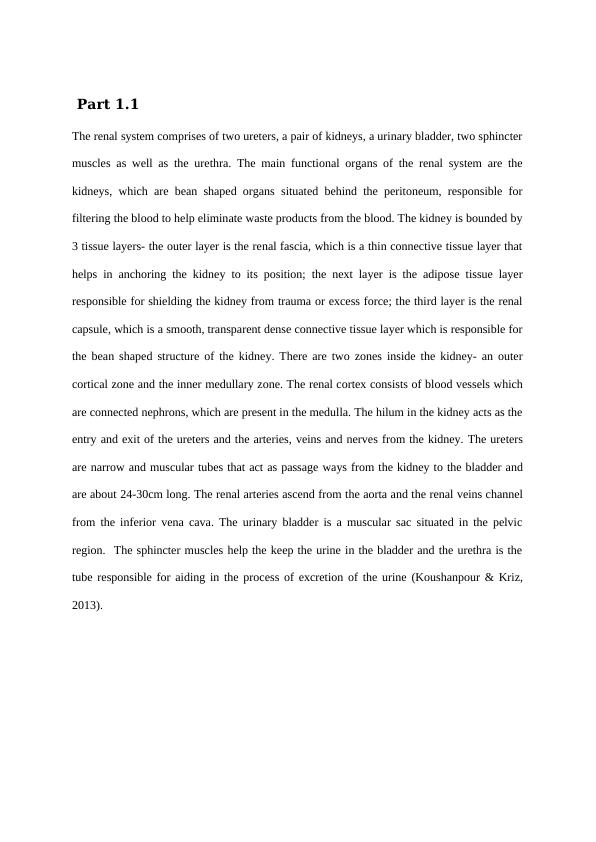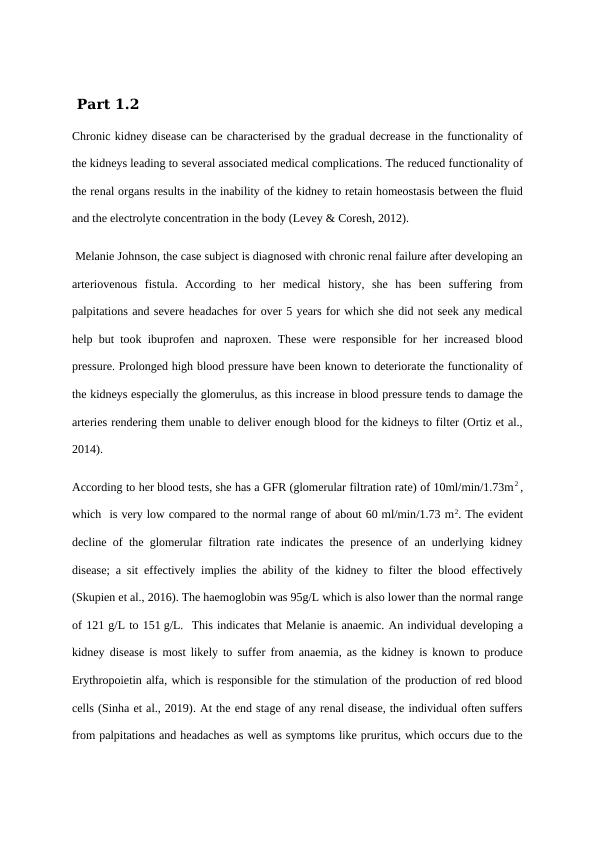Understanding Renal System and Chronic Kidney Disease: A Case Scenario
15 Pages3555 Words444 Views
Added on 2022-11-10
About This Document
This document explains the renal system and chronic kidney disease through a case scenario. It covers the risk factors, interventions, and medications used for treatment.
Understanding Renal System and Chronic Kidney Disease: A Case Scenario
Added on 2022-11-10
ShareRelated Documents
Assessment task 2 - Case Scenario
Student Name
University Name
Student Notes
Student Name
University Name
Student Notes

Part 1.1
The renal system comprises of two ureters, a pair of kidneys, a urinary bladder, two sphincter
muscles as well as the urethra. The main functional organs of the renal system are the
kidneys, which are bean shaped organs situated behind the peritoneum, responsible for
filtering the blood to help eliminate waste products from the blood. The kidney is bounded by
3 tissue layers- the outer layer is the renal fascia, which is a thin connective tissue layer that
helps in anchoring the kidney to its position; the next layer is the adipose tissue layer
responsible for shielding the kidney from trauma or excess force; the third layer is the renal
capsule, which is a smooth, transparent dense connective tissue layer which is responsible for
the bean shaped structure of the kidney. There are two zones inside the kidney- an outer
cortical zone and the inner medullary zone. The renal cortex consists of blood vessels which
are connected nephrons, which are present in the medulla. The hilum in the kidney acts as the
entry and exit of the ureters and the arteries, veins and nerves from the kidney. The ureters
are narrow and muscular tubes that act as passage ways from the kidney to the bladder and
are about 24-30cm long. The renal arteries ascend from the aorta and the renal veins channel
from the inferior vena cava. The urinary bladder is a muscular sac situated in the pelvic
region. The sphincter muscles help the keep the urine in the bladder and the urethra is the
tube responsible for aiding in the process of excretion of the urine (Koushanpour & Kriz,
2013).
The renal system comprises of two ureters, a pair of kidneys, a urinary bladder, two sphincter
muscles as well as the urethra. The main functional organs of the renal system are the
kidneys, which are bean shaped organs situated behind the peritoneum, responsible for
filtering the blood to help eliminate waste products from the blood. The kidney is bounded by
3 tissue layers- the outer layer is the renal fascia, which is a thin connective tissue layer that
helps in anchoring the kidney to its position; the next layer is the adipose tissue layer
responsible for shielding the kidney from trauma or excess force; the third layer is the renal
capsule, which is a smooth, transparent dense connective tissue layer which is responsible for
the bean shaped structure of the kidney. There are two zones inside the kidney- an outer
cortical zone and the inner medullary zone. The renal cortex consists of blood vessels which
are connected nephrons, which are present in the medulla. The hilum in the kidney acts as the
entry and exit of the ureters and the arteries, veins and nerves from the kidney. The ureters
are narrow and muscular tubes that act as passage ways from the kidney to the bladder and
are about 24-30cm long. The renal arteries ascend from the aorta and the renal veins channel
from the inferior vena cava. The urinary bladder is a muscular sac situated in the pelvic
region. The sphincter muscles help the keep the urine in the bladder and the urethra is the
tube responsible for aiding in the process of excretion of the urine (Koushanpour & Kriz,
2013).

Part 1.2
Chronic kidney disease can be characterised by the gradual decrease in the functionality of
the kidneys leading to several associated medical complications. The reduced functionality of
the renal organs results in the inability of the kidney to retain homeostasis between the fluid
and the electrolyte concentration in the body (Levey & Coresh, 2012).
Melanie Johnson, the case subject is diagnosed with chronic renal failure after developing an
arteriovenous fistula. According to her medical history, she has been suffering from
palpitations and severe headaches for over 5 years for which she did not seek any medical
help but took ibuprofen and naproxen. These were responsible for her increased blood
pressure. Prolonged high blood pressure have been known to deteriorate the functionality of
the kidneys especially the glomerulus, as this increase in blood pressure tends to damage the
arteries rendering them unable to deliver enough blood for the kidneys to filter (Ortiz et al.,
2014).
According to her blood tests, she has a GFR (glomerular filtration rate) of 10ml/min/1.73m2 ,
which is very low compared to the normal range of about 60 ml/min/1.73 m2. The evident
decline of the glomerular filtration rate indicates the presence of an underlying kidney
disease; a sit effectively implies the ability of the kidney to filter the blood effectively
(Skupien et al., 2016). The haemoglobin was 95g/L which is also lower than the normal range
of 121 g/L to 151 g/L. This indicates that Melanie is anaemic. An individual developing a
kidney disease is most likely to suffer from anaemia, as the kidney is known to produce
Erythropoietin alfa, which is responsible for the stimulation of the production of red blood
cells (Sinha et al., 2019). At the end stage of any renal disease, the individual often suffers
from palpitations and headaches as well as symptoms like pruritus, which occurs due to the
Chronic kidney disease can be characterised by the gradual decrease in the functionality of
the kidneys leading to several associated medical complications. The reduced functionality of
the renal organs results in the inability of the kidney to retain homeostasis between the fluid
and the electrolyte concentration in the body (Levey & Coresh, 2012).
Melanie Johnson, the case subject is diagnosed with chronic renal failure after developing an
arteriovenous fistula. According to her medical history, she has been suffering from
palpitations and severe headaches for over 5 years for which she did not seek any medical
help but took ibuprofen and naproxen. These were responsible for her increased blood
pressure. Prolonged high blood pressure have been known to deteriorate the functionality of
the kidneys especially the glomerulus, as this increase in blood pressure tends to damage the
arteries rendering them unable to deliver enough blood for the kidneys to filter (Ortiz et al.,
2014).
According to her blood tests, she has a GFR (glomerular filtration rate) of 10ml/min/1.73m2 ,
which is very low compared to the normal range of about 60 ml/min/1.73 m2. The evident
decline of the glomerular filtration rate indicates the presence of an underlying kidney
disease; a sit effectively implies the ability of the kidney to filter the blood effectively
(Skupien et al., 2016). The haemoglobin was 95g/L which is also lower than the normal range
of 121 g/L to 151 g/L. This indicates that Melanie is anaemic. An individual developing a
kidney disease is most likely to suffer from anaemia, as the kidney is known to produce
Erythropoietin alfa, which is responsible for the stimulation of the production of red blood
cells (Sinha et al., 2019). At the end stage of any renal disease, the individual often suffers
from palpitations and headaches as well as symptoms like pruritus, which occurs due to the

decreased nephron functionality that in turn reduces the rate of removal of the waste products
like urea from the blood stream.
Her Serum Potassium was found to be 5.7 mmol/L, which indicated the condition of
Hyperkalaemia. This inability of the kidneys to aid in the secretion of potassium in the urine
can cause arrhythmia, for which she might have faced symptoms like increased tiredness as
well as palpitations and headaches (Hoss et al., 2016).
In Melanie’s case, her age, prolonged untreated hypertension, symptoms like palpitations, use
of non-steroidal anti-inflammatory drug Ibuprofen, arrhythmia, anaemia, hyperkalemia, and
improper diet are some of the risk factors which might have aided in the incidence of this
disease. Other than these, her occupational factors like exposure to different chemicals while
farming as well as her socio-economic status to not being able to afford her medical expenses
and her ignorance which can be due to her lack of knowledge and awareness of the severity
of her condition might have also helped in the progression of the disease to the end stage.
The main aim of the treatment process is to regain the effective functionality of her kidneys.
Thus the nephrologist can recommend some long term as well as some instant and short term
interventions which will help her condition. The long term goals may include a balanced diet
with different variations to help encourage her to venture out of her farm for food, as well as
lifestyle modifications which might help her be more exposed to sunlight in order to help
regain her vitamin D levels that can aid her in improving her kidney’s health (Jean,
Souberbielle & Chazot, 2017). She can also be advised to not be over exposed to the farming
chemicals which might aggravate her skin itching. She can also be given vitamin supplements
and advised against sodium and protein intake. She will require dialysis to help filter her
blood from waste products. She can also be given short term interventions like drugs – anti
like urea from the blood stream.
Her Serum Potassium was found to be 5.7 mmol/L, which indicated the condition of
Hyperkalaemia. This inability of the kidneys to aid in the secretion of potassium in the urine
can cause arrhythmia, for which she might have faced symptoms like increased tiredness as
well as palpitations and headaches (Hoss et al., 2016).
In Melanie’s case, her age, prolonged untreated hypertension, symptoms like palpitations, use
of non-steroidal anti-inflammatory drug Ibuprofen, arrhythmia, anaemia, hyperkalemia, and
improper diet are some of the risk factors which might have aided in the incidence of this
disease. Other than these, her occupational factors like exposure to different chemicals while
farming as well as her socio-economic status to not being able to afford her medical expenses
and her ignorance which can be due to her lack of knowledge and awareness of the severity
of her condition might have also helped in the progression of the disease to the end stage.
The main aim of the treatment process is to regain the effective functionality of her kidneys.
Thus the nephrologist can recommend some long term as well as some instant and short term
interventions which will help her condition. The long term goals may include a balanced diet
with different variations to help encourage her to venture out of her farm for food, as well as
lifestyle modifications which might help her be more exposed to sunlight in order to help
regain her vitamin D levels that can aid her in improving her kidney’s health (Jean,
Souberbielle & Chazot, 2017). She can also be advised to not be over exposed to the farming
chemicals which might aggravate her skin itching. She can also be given vitamin supplements
and advised against sodium and protein intake. She will require dialysis to help filter her
blood from waste products. She can also be given short term interventions like drugs – anti

End of preview
Want to access all the pages? Upload your documents or become a member.
Related Documents
Anatomy and Physiology of Urinary System: A Comprehensive Overviewlg...
|4
|781
|454
Understanding Renal Failure: Causes, Symptoms, and Treatmentlg...
|13
|3239
|39
Chronic Renal Failure: Pathophysiology, Treatment Options, and Medicationslg...
|11
|2815
|369
Understanding the Urinary System: Anatomy and Functionslg...
|18
|4228
|211
Case Study of Melanie: Medical History, Renal Failure, and Hemodialysislg...
|7
|1619
|429
Kidneys and Urinary Tractlg...
|5
|794
|39
